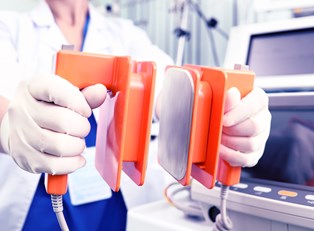A patient who has a history of irregular heartbeat rhythms that can cause sudden cardiac arrest and death may require a defibrillator to shock his or her heart when it stops pumping blood or gets stuck in a cycle of irregular beating rhythms that prevent effective circulation. These rhythm irregularities are known as arrhythmias.
Not all arrhythmias are concerning but those involving the ventricles, such as ventricular tachycardia and ventricular fibrillation, can be fatal. Wearable cardioverter defibrillators (WCDs), also known as life vests or defibrillator vests, are one type of device used to address these heart issues.
ICD Defibrillators vs. WCD Defibrillators
If you have heart disease, have had a heart attack, or have existing damage to your heart’s muscular tissue, you may be at risk of experiencing sudden cardiac arrest. Many patients in this situation are candidates for implantable cardioverter defibrillators (ICDs). These are miniature defibrillators that are surgically placed beneath the skin in the chest near the heart. ICDs can monitor and record heart rhythms. Much like pacemakers, ICDs can deliver low-energy pulses that can correct minor arrhythmias, but their primary function is to defibrillate, or restore normal heart rhythms through high-energy shocks.
Some patients either do not require a permanent defibrillator placement or are awaiting the ICD surgery and need protection in the meantime. Defibrillator vests are a temporary solution and are usually not used for more than 60 days.
Unlike automatic external defibrillators, which are used in hospitals and schools, offices, and other public places, the wearable cardioverter defibrillator does not require bystander assistance. If you are alone and experience cardiac arrest, the vest defibrillator will deliver shock pulses on its own.
How WCDs Are Worn
Wearable cardioverter defibrillators are worn as a garment that monitors heart rhythms through sensors placed against the skin. Wearing a WCD involves transporting a small box, or monitor, around the waist on a hip belt or from a shoulder strap. The vest component, which connects to the monitor through wires known as leads, is worn around the chest and under the clothing. Electrodes are sensors that are either applied to the skin or built into the vest. Some patients complain of discomfort when wearing the vest defibrillator or bearing the additional weight of the monitoring device.
Drawbacks of WCDs
There are times, such as when bathing, when the WCD may not be worn, thus leaving you potentially vulnerable to cardiac arrest during certain periods of time. The American Heart Association recommends engaging in these activities when someone can be with you to monitor your condition. Another limitation with the WCD is that it functions more as an all-or-nothing device. WCDs do not function like pacemakers that minor arrhythmias like ICDs do. Patients must wear the device properly and be more conscious of WCDs than those with implanted defibrillators.
Sometimes, both implantable and wearable cardioverter defibrillators can deliver high-voltage shocks when the situation does not call for it. Before giving a shock, the vest defibrillator will sound with alarms and vibrate. Some even include auditory commands, such as a warning for bystanders to step away from the wearer. Should the alarms go off in error, there is a safety mechanism which allows you to push a button to confirm that you are conscious and cancel the delivery of shock.



